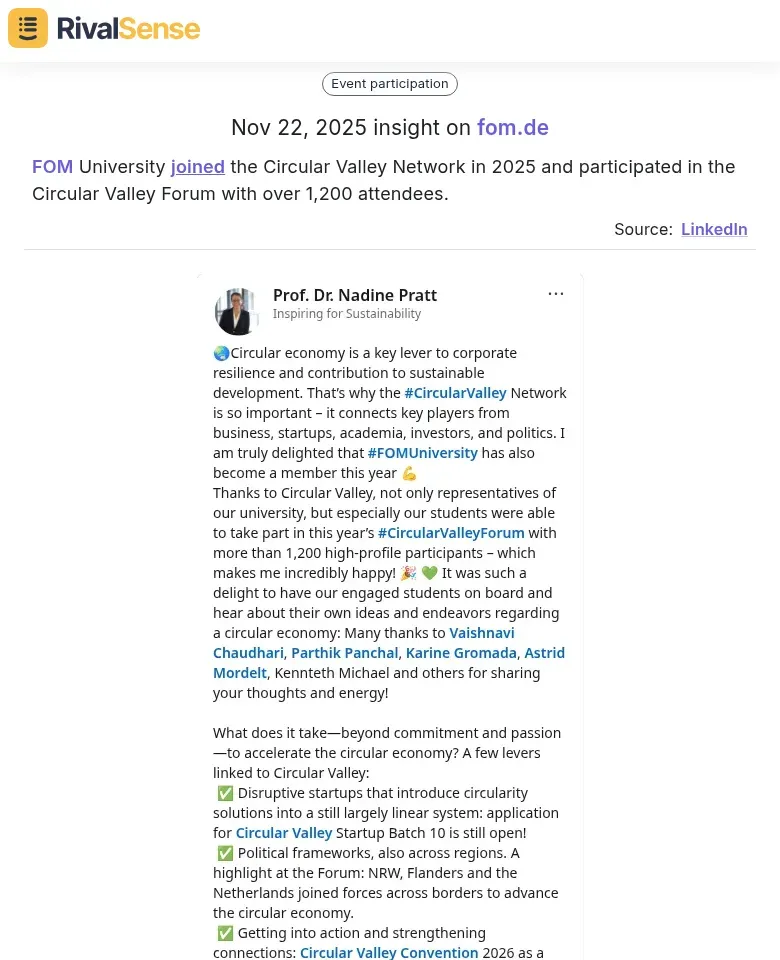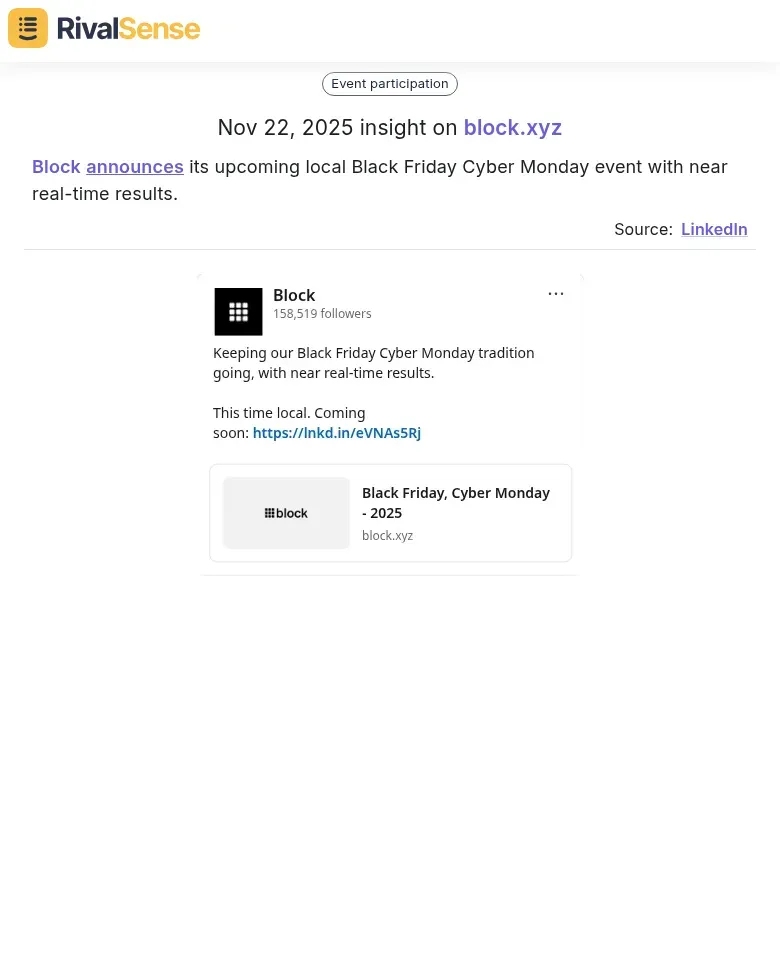Step-by-Step Guide to Analyzing Competitor Event Participation
Tracking competitor event participation provides crucial strategic intelligence that reveals market positioning, expansion priorities, and future moves. When competitors invest in specific conferences or trade shows, they're signaling their target markets, product focus areas, and partnership strategies. For example, a competitor consistently attending AI-focused events indicates a strategic pivot toward artificial intelligence solutions.
Practical tip: Create a competitor event tracking spreadsheet with columns for event name, date, competitor role (speaker, sponsor, exhibitor), key announcements, and estimated investment. This data helps anticipate industry trends—if multiple competitors flock to cybersecurity events, it signals market demand shifts.
✅ Checklist for effective monitoring:
- Monitor event websites, social media announcements, and post-event recaps.
- Analyze speaker topics for R&D insights and sponsorship levels for budget allocation patterns.
- Use tools like RivalSense to automate tracking and set alerts for real-time updates.
By systematically tracking these activities, you can identify emerging threats early and adjust your strategy proactively.
Tracking Competitor Event Announcements and Schedules
Tracking competitor event announcements reveals strategic timing and geographic priorities that can shape your business decisions. Monitoring their press releases, social media, and industry calendars for public event schedules helps you anticipate their moves and align your resources.
For instance, RivalSense recently tracked that Field CEO Katsutoshi Harada announced the company will exhibit at Tokyo Big Sight from November 26-28.  This type of insight is valuable because it alerts you to competitor presence in key international events, enabling you to assess their geographic expansion and timing for your own market entry or counter-campaigns.
This type of insight is valuable because it alerts you to competitor presence in key international events, enabling you to assess their geographic expansion and timing for your own market entry or counter-campaigns.
Analyze frequency—quarterly events suggest consistent market engagement, while sporadic appearances may indicate testing new regions. Geographic focus shows market priorities; heavy US presence versus European expansion signals resource allocation. Event schedules predict campaign timing—product launches often align with major conferences.
✅ Checklist for tracking announcements:
- Document event dates, locations, themes, and key personnel attending.
- Set up Google Alerts for competitor names plus keywords like 'speaking' or 'sponsoring'.
- Use automated tools to capture announcements and avoid missing critical updates.
This data helps anticipate competitor moves and align your strategy accordingly, ensuring you're not caught off guard.
Analyzing Event Types and Strategic Partnerships
Categorizing competitor events by type helps decode their strategic goals and identify potential opportunities for your business. Trade shows often signal market presence and lead generation, while industry forums indicate thought leadership ambitions and networking efforts.
RivalSense insights, such as FOM University joining the Circular Valley Network in 2025 and participating in the Circular Valley Forum with over 1,200 attendees, highlight the importance of partnership tracking.  This insight is valuable because it reveals alliance strategies and event scale, helping you evaluate partnership potential, assess audience reach, and inform your own collaboration decisions to build credibility and expand networks.
This insight is valuable because it reveals alliance strategies and event scale, helping you evaluate partnership potential, assess audience reach, and inform your own collaboration decisions to build credibility and expand networks.
Track partnership announcements—these reveal network expansion and credibility building through association with established players. For example, a SaaS company partnering with a major cloud provider demonstrates market validation. Evaluate attendee metrics: high numbers suggest broad reach, while demographic data reveals target audience alignment.
🔍 Practical steps for analysis:
- Create an event matrix categorizing by type, location, and scale.
- Analyze partnership press releases for mutual benefits and strategic alignment.
- Track year-over-year attendee growth and demographic shifts to spot trends.
Tip: Compare your event participation against competitors to identify gaps in market engagement and refine your approach.
Extracting Insights from Event-Specific Campaigns and Results
Event participation offers a goldmine of competitive intelligence when analyzed systematically, allowing you to learn from competitors' successes and failures. Start by tracking real-time outcomes, such as social media engagement, lead generation numbers, and media mentions during the event itself, to gauge immediate impact.
For example, RivalSense captured that Block announces its upcoming local Black Friday Cyber Monday event with near real-time results.  This insight is valuable because it provides a window into promotional tactics and real-time engagement metrics, enabling you to benchmark performance, adapt your campaigns on the fly, and identify best practices for driving customer interactions.
This insight is valuable because it provides a window into promotional tactics and real-time engagement metrics, enabling you to benchmark performance, adapt your campaigns on the fly, and identify best practices for driving customer interactions.
Examine promotional tactics by reviewing event materials, booth designs, and sponsorship levels. Look for patterns in how competitors engage attendees—do they use gamification, exclusive demos, or VIP sessions? Document their customer engagement strategies, such as follow-up sequences or special offers tied to event attendance.
📊 Post-event analysis checklist:
- Review post-event surveys, press coverage, and sales pipeline impact.
- Measure ROI against competitor spend to identify cost-effective strategies.
- Update your strategy based on what worked (or didn't) for competitors to fill gaps.
This continuous learning loop turns events into strategic advantages, helping you optimize future participation.
Implementing a Systematic Competitor Event Tracking Process
Implementing a systematic competitor event tracking process starts with setting up monitoring tools and alerts to ensure no critical information is missed. Developing a structured framework for consistent analysis allows you to transform raw data into actionable insights that drive decision-making.
Use tools like RivalSense to track competitor announcements, social media posts, and industry event calendars automatically. Set up Google Alerts for competitor names plus keywords like 'speaking,' 'sponsoring,' or 'webinar' to capture additional data points. Create a centralized dashboard to log all event activities, noting key metrics for easy reference.
| Metric | Description |
|---|---|
| Event Date | Specific dates of competitor events |
| Location | Geographic focus (e.g., city, country) |
| Session Topics | Key themes and discussions covered |
| Attendee Engagement | Metrics like social media mentions or lead counts |
Next, develop a framework for consistent analysis. Use a standardized template to record insights: categorize events by type (e.g., trade shows, webinars), assess competitor messaging and positioning, and evaluate their audience reach. Assign team members to review and update this data weekly to maintain accuracy.
💡 Tips for integration:
- Automate data collection where possible to save time and reduce errors.
- Involve cross-functional teams in reviews to gain diverse perspectives.
- Tie event insights to KPIs like market share or lead generation for measurable impact.
Integrate event data into broader competitive intelligence by mapping it against your strategic goals. For example, if a competitor frequently sponsors tech conferences, analyze how this aligns with their product launches to anticipate future moves.
Conclusion: Turning Insights into Actionable Strategies
In conclusion, analyzing competitor event participation provides a strategic edge by revealing market trends, gaps, and opportunities that can inform your business decisions. Key takeaways include identifying high-impact events, understanding competitor messaging, and spotting partnership avenues to enhance your market position.
To turn insights into action, develop counter-strategies: if competitors dominate a niche conference, host a rival webinar or launch a targeted campaign to capture their audience. Use a checklist to map events by ROI potential, align with product launches, and allocate budget for unexpected opportunities that arise from competitor movements.
✅ Actionable checklist:
- Continuously monitor events using tools like RivalSense to track changes in real-time.
- Adapt to dynamic markets by integrating insights into quarterly strategy reviews.
- Proactively position your business by anticipating moves rather than just reacting.
Ready to streamline your competitor event tracking? Try out RivalSense for free at https://rivalsense.co/ and get your first competitor report today to stay ahead of the competition!
📚 Read more
👉 Mastering Competitor Analysis: Insights from ImpactEd Group's Initiative
👉 The Ultimate Guide to Key Account Tracking Automation in 2025
👉 How to Track Competitor Funding for Supply Chain Optimization
👉 How Vanta's Middle East Move Spurred Competitor Action
👉 How Website Changes Reveal Competitor Strategies for Key Accounts
